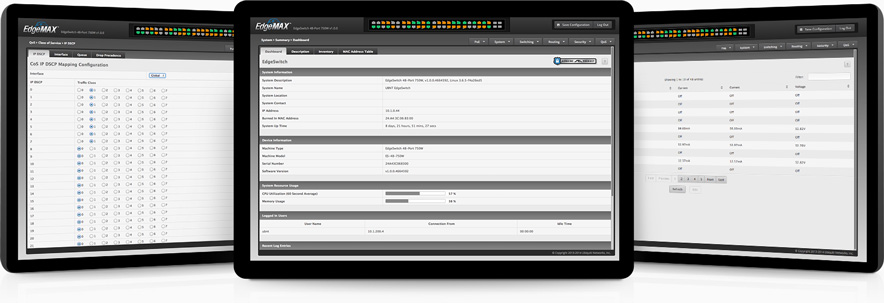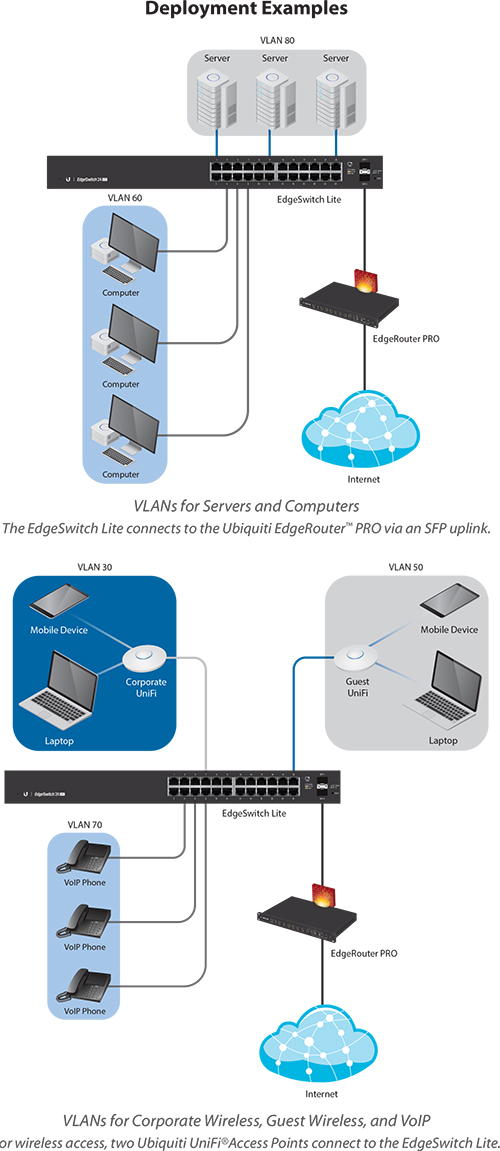Introduction
The Ubiquiti EdgeSwitch Lite 48 is a fully managed, Gigabit switch, delivering robust performance and intelligent switching for growing networks. The EdgeSwitch Lite offers an extensive suite of advanced Layer 2 switching features and protocols, and also provides Layer 3 routing capability.
Ubiquiti EdgeSwitch Lite 48 Key Features
- (48) Gigabit RJ45 Ports
- (2) SFP+ Ports
- (2) SFP Ports
- (1) Serial Console Port
- Non-Blocking Throughput: 70 Gbps
- Switching Capacity: 140 Gbps
- Forwarding Rate: 104.16 Mpps
Optical Fiber Backhaul
Two SFP ports support uplinks of up to 1 Gbps. For high-capacity uplinks, the EdgeSwitch Lite 48 includes two SFP+ ports for uplinks of up to 10 Gbps.
Powerful Enterprise Switch
The EdgeSwitch Lite 48 simultaneously processes traffic on all ports at line rate without any packet loss. Total non-blocking throughput is up to 70 Gbps for the EdgeSwitch Lite 48.
 Advanced UI
Advanced UI
Designed for convenient management, the EdgeSwitch Lite 48 Configuration Interface allows administrators to configure and monitor switch features in a graphical user interface. For advanced users, an industry-standard command-line interface (CLI) is available through the serial console port, telnet, and SSH.


Specifications
General
- Dimensions: 443 x 43 x 221 mm (17.44 x 1.69 x 8.70")
- Weight:
Rack-Mount Brackets Included - 2.6 kg (5.7 lb)
Rack-Mount Brackets Excluded - 2.51 kg (5.53 lb)
- Total Non-Blocking Throughput: 26 Gbps
- Switching Capacity: 52 Gbps
- Forwarding Rate: 38.69 Mpps
- Max. AC Power Consumption: 25W
- Power Method: 100-240VAC/50-60 Hz, Universal Input DC 25V/25W Min.
- Power Supply: AC/DC, Internal, 25W DC
- LEDs: Per Port
- Serial Console Port: N/A
- RJ45 Data Ports: Speed/Link/Activity
- SFP Data Ports: Speed/Link/Activity
- Networking Interface: (24) 10/100/1000 Mbps RJ45 Ethernet Ports, (2) 1 Gbps SFP Ethernet Ports
- Management Interface: (1) RJ45 Serial Port, Ethernet In/Out Band
- Certifications: CE, FCC, IC
- Rackmount: Yes, 1U High
- ESD/EMP Protection: Air: ±24 kV, Contact: ±24 kV
- Operating Temperature: -5 to 40° C (23 to 104° F)
- Operating Humidity: 5 to 95% Noncondensing
- Shock and Vibration: ETSI300-019-1.4 Standard
Core Switching Features
- ANSI/TIA-1057: LLDP-Media Endpoint Discovery (MED)
- IEEE 802.1AB: Link Layer Discovery Protocol (LLDP)
- IEEE 802.1D: Spanning Tree Compatibility
- IEEE 802.1S: Multiple Spanning Tree Compatibility
- IEEE 802.1W: Rapid Spanning Tree Compatibility
- IEEE 802.1Q: Virtual LANs with Port-Based VLANs
- IEEE 802.1p: Ethernet Priority with User Provisioning and Mapping
- IEEE 802.1X: Port-Based Authentication with Guest VLAN Support
- IEEE 802.3: 10BASE-T
- IEEE 802.3u: 100BASE-T
- IEEE 802.3ab: 1000BASE-T
- IEEE 802.1ak: Virtual Bridged Local Area Networks - Amendment 07: Multiple Registration Protocol
- IEEE 802.3ac: VLAN Tagging
- IEEE 802.3ad: Link Aggregation
- IEEE 802.3x: Flow Control
- IEEE 802.1D-2004: Generic Attribute Registration Protocol: Clause 12 (GARP)
- IEEE 802.1D-2004: Dynamic L2 multicast registration: Clause 10 (GMRP)
- IEEE 802.1Q-2003: Dynamic VLAN registration: Clause 11.2 (GVRP)
- RFC 4541: Considerations for Internet Group Management Protocol (IGMP) Snooping Switches
- RFC 5171: Unidirectional Link Detection (UDLD) Protocol
Advanced Layer 2 Features
- Broadcast Storm Recovery
- Broadcast/Multicast/Unknown Unicast Storm Recovery
- DHCP Snooping
- IGMP Snooping Querier
- Independent VLAN Learning (IVL) Support
- Jumbo Ethernet Frame Support
- Port MAC Locking
- Port Mirroring
- Protected Ports
- Static MAC Filtering
- TACACS+
- Voice VLANs
- Unauthenticated VLAN
- Internal 802.1X Authentication Server
Platform Specifications
- DHCP Server
- Maximum Number of Pools: 8
- Maximum Number of Leases (Total): 128
- Routing
- Number of Routes: 16
- Number of Routing Interfaces: 15
- VLANs: 255
- MAC Addresses: 8k
- MSTP Instances: 4
- LAGs: 6
- ACLs: 100 with 10 Rules per Port
- Traffic Classes (Queues): 8
System Facilities
- Event and Error Logging Facility
- Run-Time and Configuration Download Capability
- PING Utility
- FTP/TFTP Transfers via IPv4/IPv6
- Malicious Code Detection
- BootP and DHCP
- RFC 2021: Remote Network Monitoring Management Information Base Version 2
- RFC 2030: Simple Network Time Protocol (SNTP)
- RFC 2819: Remote Network Monitoring Management Information Base
- RFC 2865: RADIUS Client
- RFC 2866: RADIUS Accounting
- RFC 2868: RADIUS Attributes for Tunnel Protocol Support
- RFC 2869: RADIUS Extensions
- RFC 3579: RADIUS Support for EAP
- RFC 3580: IEEE 802.1X RADIUS Usage Guidelines
- RFC 3164: BSD Syslog Protocol
Management
- Web UI
- Industry-Standard CLI
- IPv6 Management
- Password Management
- Autoinstall Support for Firmware Images and Configuration Files
- SNMP v1, v2, and v3
- SSH 1.5 and 2.0
- SSL 3.0 and TLS 1.0
- Secure Copy (SCP)
- Telnet (Multi-Session Support)
Layer 3
- Static Routing
- Policy Based Routing
QoS
- Access Control Lists (ACLs), Permit/Deny Actions for Inbound IP and Layer 2 Traffic Classification Based on:
Time-Based ACL
Source/Destination IP Address
TCP/UDP Source/Destination Port
IP Protocol Type
Type of Service (ToS) or Differentiated Services (DSCP) Field
Source/Destination MAC Address
EtherType
IEEE 802.1p User Priority
VLAN ID
RFC 1858: Security Considerations for IP Fragment Filtering
- Optional ACL Rule Attributes
Assign Flow to a Specific Class of Service (CoS) Queue
Redirect Matching Traffic Flows
- Differentiated Services (DiffServ)
Classify Traffic Based on Same Criteria as ACLs
Mark the IP DSCP or Precedence Header Fields, Optional
Police the Flow to a Specific Rate with Two-Color Aware Support
RFC 2474: Definition of the Differentiated Services Field (DS field) in the IPv4 and IPv6 Headers
RFC 2475: An Architecture for Differentiated Services
RFC 2597: Assured Forwarding Per-Hop Behavior (PHB) Group
RFC 3246: An Expedited Forwarding PHB
RFC 3260: New Terminology and Clarifications for DiffServ
- Class of Service (CoS) Queue Mapping Configuration
AutoVoIP: Automatic CoS Settings for VoIP
IP DSCP-to-Queue Mapping
Configurable Interface Trust Mode (IEEE 802.1p, DSCP, or Untrusted)
Interface Egress Shaping Rate
Strict Priority versus Weighted Scheduling per Queue


 Advanced UI
Advanced UI
